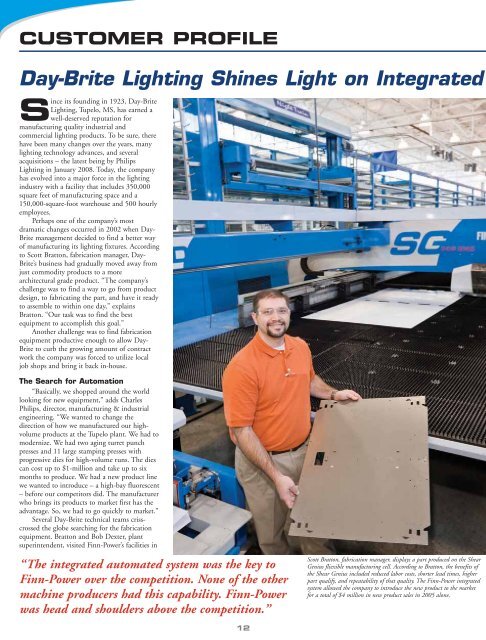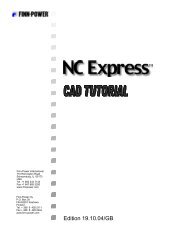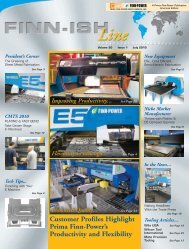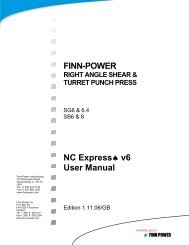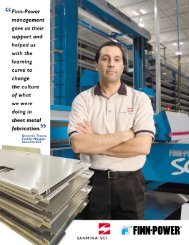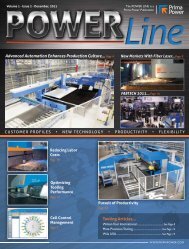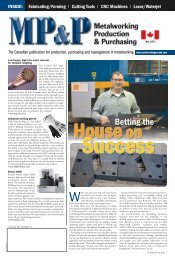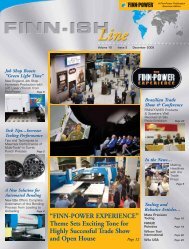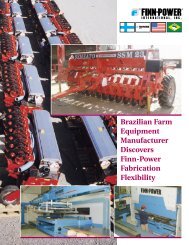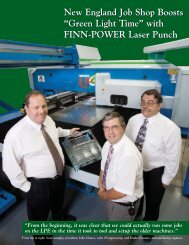volume 18 - issue 1 - Finn-Power International, Inc.
volume 18 - issue 1 - Finn-Power International, Inc.
volume 18 - issue 1 - Finn-Power International, Inc.
You also want an ePaper? Increase the reach of your titles
YUMPU automatically turns print PDFs into web optimized ePapers that Google loves.
CUSTOMER PROFILE<br />
Day-Brite Lighting Shines Light on Integrated<br />
Since its founding in 1923, Day-Brite<br />
Lighting, Tupelo, MS, has earned a<br />
well-deserved reputation for<br />
manufacturing quality industrial and<br />
commercial lighting products. To be sure, there<br />
have been many changes over the years, many<br />
lighting technology advances, and several<br />
acquisitions – the latest being by Philips<br />
Lighting in January 2008. Today, the company<br />
has evolved into a major force in the lighting<br />
industry with a facility that includes 350,000<br />
square feet of manufacturing space and a<br />
150,000-square-foot warehouse and 500 hourly<br />
employees.<br />
Perhaps one of the company’s most<br />
dramatic changes occurred in 2002 when Day-<br />
Brite management decided to find a better way<br />
of manufacturing its lighting fixtures. According<br />
to Scott Bratton, fabrication manager, Day-<br />
Brite’s business had gradually moved away from<br />
just commodity products to a more<br />
architectural grade product. “The company’s<br />
challenge was to find a way to go from product<br />
design, to fabricating the part, and have it ready<br />
to assemble to within one day,” explains<br />
Bratton. “Our task was to find the best<br />
equipment to accomplish this goal.”<br />
Another challenge was to find fabrication<br />
equipment productive enough to allow Day-<br />
Brite to curb the growing amount of contract<br />
work the company was forced to utilize local<br />
job shops and bring it back in-house.<br />
The Search for Automation<br />
“Basically, we shopped around the world<br />
looking for new equipment,” adds Charles<br />
Philips, director, manufacturing & industrial<br />
engineering. “We wanted to change the<br />
direction of how we manufactured our high<strong>volume</strong><br />
products at the Tupelo plant. We had to<br />
modernize. We had two aging turret punch<br />
presses and 11 large stamping presses with<br />
progressive dies for high-<strong>volume</strong> runs. The dies<br />
can cost up to $1-million and take up to six<br />
months to produce. We had a new product line<br />
we wanted to introduce – a high-bay fluorescent<br />
– before our competitors did. The manufacturer<br />
who brings its products to market first has the<br />
advantage. So, we had to go quickly to market.”<br />
Several Day-Brite technical teams crisscrossed<br />
the globe searching for the fabrication<br />
equipment. Bratton and Bob Dexter, plant<br />
superintendent, visited <strong>Finn</strong>-<strong>Power</strong>’s facilities in<br />
“The integrated automated system was the key to<br />
<strong>Finn</strong>-<strong>Power</strong> over the competition. None of the other<br />
machine producers had this capability. <strong>Finn</strong>-<strong>Power</strong><br />
was head and shoulders above the competition.”<br />
12<br />
Scott Bratton, fabrication manager, displays a part produced on the Shear<br />
Genius fliexible manufacturing cell. According to Bratton, the benefits of<br />
the Shear Genius included reduced labor costs, shorter lead times, higher<br />
part qualify, and repeatability of that quality. The <strong>Finn</strong>-<strong>Power</strong> integrated<br />
system allowed the company to introduce the new product to the market<br />
for a total of $4 million in new product sales in 2005 alone.


